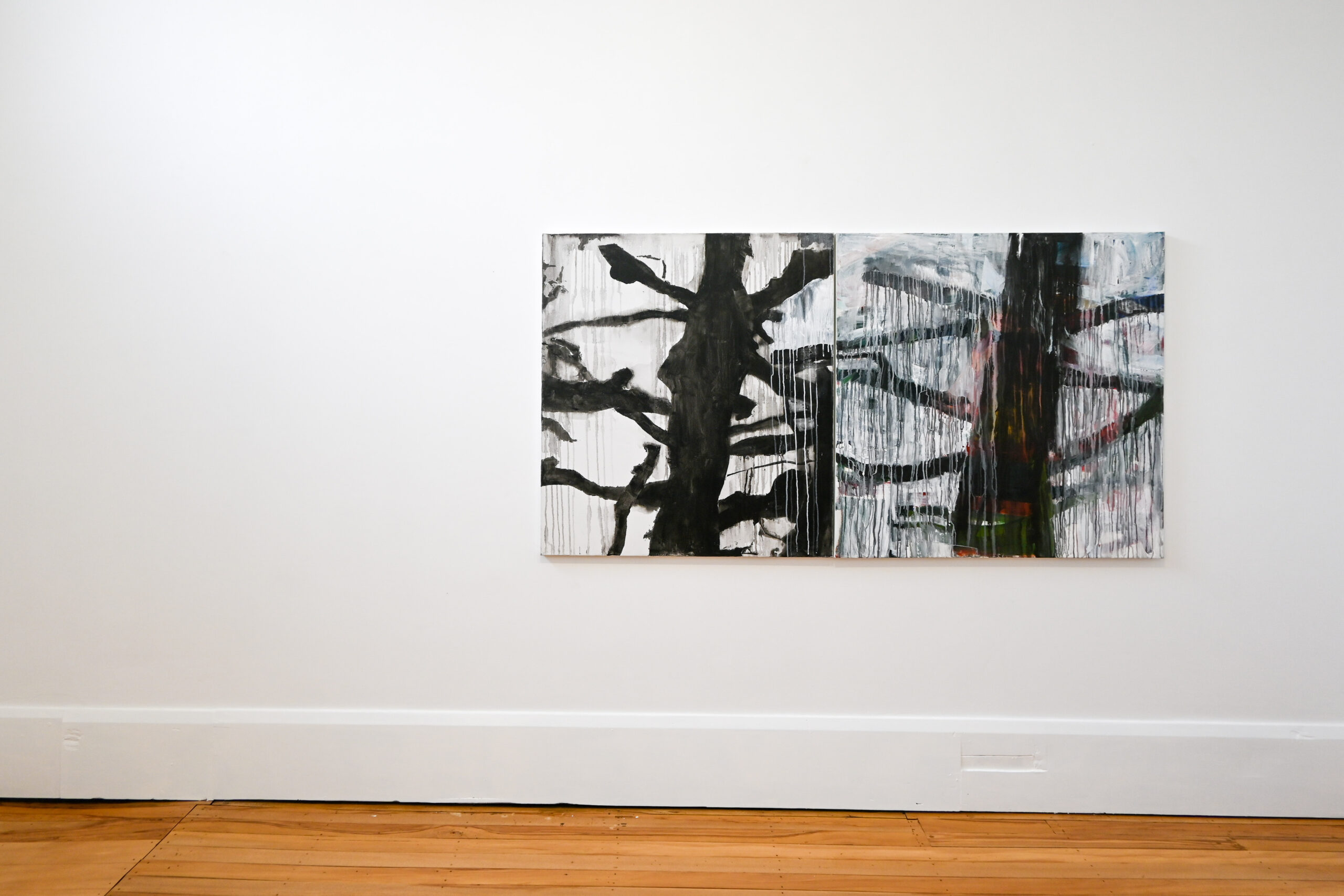
Kahikatea – Moss and Mist
Recent paintings by Jessica Crothall
ATELIER Studio|Gallery 26 August-27 September 2023
As the morning sun clambers over the hill it spills through the bare winter trees, casting blurred shadows on a white wall somewhere in the city. A lattice work of lines, thick and thin, crooked and straight, they gently move in an unfelt breeze, weaving between the recognizable and the abstract. So it is with Jessica Crothall’s latest body of work, Kahikatea: Moss and Mist.
On display at the light infused rooms of Atelier Gallery in Nelson/Whakatu, the paintings are decoded by the exhibition title, and we are transported into the dense forests of South Westland. Considered brushstrokes draw out knobbly branches and solid trunks. Dripping paint conjures up verdant growth tumbling off the limbs, captured by gravity and imagination, and the heavy air imbued with moisture. You can almost hear the drip drip drip of water hitting the forest floor, smell the rain as it permeates the ground. Here the artist draws on those who came before, Hammond, McLeod, their influence echoing through the years to meet us in the present. By no means is Crothall’s work imitation though, rather she’s utilizing visual clues that are part of the cultural landscape. She applies particular techniques that prompt association while maintaining her own abstract language. Supported by individual titles the works lead us to experience the natural world. Yet a small shift in perception can transform them, as if they’re dancing on the cusp of reality.
I am reminded of Plato, the shadows in his cave and thoughts of Form and essences. The brushwork is like those shadows, cast on canvas, seeking to capture the essence of the mighty kahikatea, not it’s likeness. A case of ‘the thing is not the thing, but the idea of the thing’. If we follow that thought, where does the shadow of a shadow take us? Are Crothall’s renditions further from, or closer to, Plato’s Form? Abstract responses, like Crothall’s work, have a particular ability to bypass the seen, and head straight into metaphysics.
To achieve this restful contemplation, Crothall washes down her paint, pushing the acrylic into the realms of watercolour, using it as in Japanese or Indian ink. Her works further reference Japanese sumi-e paintings in their reflective sensibility, drawing inspiration from the natural world to encourage deeper thoughts of being.
Each canvas plays with a different colour palette, most monochromatic in implementation. Some investigate the expected green spectrum but the blue and the black studies stand out, in particular the two Kaitiaki’s. Kaitiaki Blue is saturated, literally. Here Crothall has poured unknown quantities of water on the canvas, causing the dripped paint to bleed out, crawl through the background to create organic strands of descending vegetation. It is dense, without becoming heavy, rugged yet refreshing.
Likewise, the presence of Kaitiaki Black is irrefutable. Paired with Curtains of Rain in the smaller gallery, it is the most tempestuous work on display. The dark trunk is interspersed with reds and greens, climbing through the layers; a profusion of drips falling off the branches. In the background, we see an unsettled sky of quick, broad brushstrokes. It is the storm arrived, wind howling, rain pelting down. In a collection of paintings who all display their own mood, or weather, Kaitiaki Black and its placement reflects tight curation. It injects a sense of drama and a shift in perception about storms. We are encouraged to embrace them, rather than shrink back.
In her statement, Crothall discusses her fascination with the amount of external growth kahikateas can carry as well as supporting each other. In the soft, saturated ground the kahikateas’ roots intertwine with their neighbours, forming an underground latticed structure that helps ground them as they reach skywards. Without this support they would soon topple, as the springy ground is unable to hold them. In the paintings this is made plain by the suggestion of multiple trees, none stand alone. Even where there is only one bough present on the canvas, the presence of others is alluded to by interlacing lines and shadows of shadows. It is a curious thing, that artworks that benefit from solitary contemplation would create an atmosphere of togetherness.
Kahikatea: Moss and Mist displays a new level of repose in Crothall’s approach. Where much of her work through the last decade responding to the Christchurch earthquakes has been unsettled and jagged, this exhibition exhibits, perhaps, newfound acceptance and peace. Finding her roots, and in the process encouraging us to consider ours.
Linda Dimitrievski – Arts Writer

